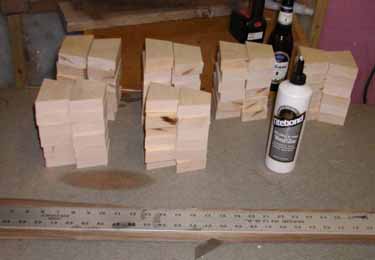I was asked to do a short tutorial on making segmented bowls...
so here's my feeble attempt...
I'm not an expert, and mine may not be the best way.
This is simply my approach.
Segmented bowls aren't as hard as they look.
They take lots of time, and a little patience.
As far as basic equipment, you need:
a good lathe,
chuck / faceplate,
tablesaw or mitersaw, and a
good miter gauge.
As always, make sure everything's tuned up, ready to
make accurate smooth cuts.
The basic idea, as most of you know, is to
take perfectly good timbers and
chop them up into little pieces, glue them back together,
and make them round.
There are lots of good books and endless designs.
For this project, I'm selecting a simple but IMHO elegant
design.
There's room for improvement, but I'm new at this, too.
First, decide how many pieces per ring.
Divide 180 by that number, and you have the angle
to use.
I'm doing 12 sided rings, so 15 degrees.
Figure out the circumference of the circle.
The formula is pi * diameter = circumference.
pi = 3.1415
Take the circumference and divide by the number
of segments, and you get the length of each long side.
Neat, huh...
For the width of each piece, I select 1.5 - 2".
That gives me plenty of room for error.
I'm just not that good yet to chance it.
Draw it out on paper, and
come up with a profile.
That way, you can figure out how big to cut each
ring.
Cut out your segments using whatever method you
prefer.
I used my miter gauge, a stop block, on tablesaw.
A word about accuracy.
In order to cut perfect rings,
you have to have a perfect angle.
The more segments in a ring, the greater the error.
For a 12 sided ring, the error is multiplied 24
times -
2 cuts each piece.
If you're accurate to 0.001", you could be off
by 0.024" in the end.
That's large enough to see visible gaps between the
mitered cuts!
There's a way around it, so just
get your setup as close as you can, and cut
your pieces.
Now that you have them cut out... It's time to
setup for glueing.
My design will be a "brick wall" pattern,
with a contrasting veneer in-between each
piece.
Get what you need.
A good straight edge,
glue,
sharp blade,
veneer,
pieces, and a
cold adult beverage, because this is the TEDIOUS
part.
|

|
|



